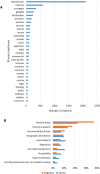Main topics in assisted reproductive market: A scoping review
- PMID: 37527215
- PMCID: PMC10393141
- DOI: 10.1371/journal.pone.0284099
Main topics in assisted reproductive market: A scoping review
Abstract
Background: Infertility affects around 12% of couples, and this proportion has been gradually increasing. In this context, the global assisted reproductive technologies (ART) market shows significant expansion, hovering around USD 26 billion in 2019 and is expected to reach USD 45 billion by 2025.
Objectives: We realized a scoping review of the ART market from academic publications, market reports, and specialized media news, to identify the main terms and characterize them into the main topics in the area.
Design: We apply an LDA topic modeling process to identify the main terms, and clustered them into semantic synonymous topics. We extracted the patterns and information to these topics and purposed a factor/consequence correlation to them.
Results: We found 2,232 academic papers and selected 632 to include in the automatic term detection. We also included 34 market reports and seven notices produced by specialized enterprises. Were identified 121 most relevant cited terms covering 7,806 citations. These terms were manually aggregated into 10 topics based on semantic similarity: neutral terms (37.2%), economic aspects (17.6%), in vitro fertilization (IVF) commodities & cross-border reproductive care (CBRC) (10.6%), geographic distribution (9.5%), social aspects (7%), regulation (6%), trends & concerns (3.9%), accessibility (3.4%), internet influence (2.9%), and fertility preservation for non-medical reasons (2%).
Discussion: The analysis indicates a market with expressive complexity. Most terms were associated with more than one topic, indicating the synergism of this market's behavior. Only seven terms related to economic aspects, surrogacy and donation represent around 50% of the citations. Except for the topic formed by generic terms, the topic of the economic aspects was the most represented, reflecting macro perspectives such as a-la-carte standard of treatments, many clinics operating on a small/medium scale, and the recent formation of conglomerates. The IVF commodities & CBRC topic brings an overview of gametes pricing and transnational surrogacy, and its regulation. The topic of geographic distribution indicates that that the Asia-Pacific (APAC) market has the most significant growth potential in all fields. Despite the increase in supply and demand for infertility treatments and technological advances in recent decades, the success rate of IVF cycles remains at around 30%. Terms referring to research and development or technical improvement were not identified in a significant way in this review.
Conclusions: The formation of topics by semantic similarity proved to be an initial path for the elaboration of in-depth studies on the dynamics between several factors, for this, we present the panel classifying main terms into factors (demand, pent-up demand, or distributive) or ART market consequences. Through this approach, it was possible to observe that most of the works addresses economic aspects, regulation and geographic aspects and that topics related to research and improvement have not been addressed. In this way, we highlight the need to deepen the analysis of market elements that may be related to increased efficiency of IVF in the technical field.
Copyright: © 2023 Aderaldo et al. This is an open access article distributed under the terms of the Creative Commons Attribution License, which permits unrestricted use, distribution, and reproduction in any medium, provided the original author and source are credited.
Conflict of interest statement
The authors declare that they have no competing interests.
Figures




References
-
- Zegers-Hochschild F, Adamson GDD, De Mouzon J, Ishihara O, Mansour R, Nygren K, et al. The International Committee for Monitoring Assisted Reproductive Technology (ICMART) and the World Health Organization (WHO) Revised Glossary on ART Terminology, 2009. Human Reproduction. 2009;24: 2683–2687. doi: 10.1093/humrep/dep343 - DOI - PubMed
-
- United Nations. World Fertility Patterns 2015 Data Booklet. UNESA Publication. 2015; 1–30.
-
- Grand View Research. Assisted Reproductive Technology (ART) Market Size, Share & Trends Analysis Report By Type (IVF, Others), By End Use (Hospitals, Fertility Clinics), By Procedures And Segment Forecasts, 2018–2025. 2018.
Publication types
MeSH terms
LinkOut - more resources
Full Text Sources
Medical
Research Materials
Miscellaneous

